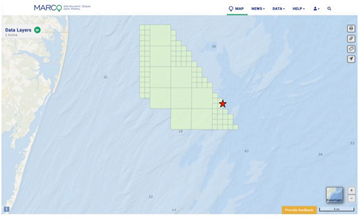TailWinds update: January 2023
This update was first featured in the January 2023 edition of the CBL Newsletter.
The US Wind group at UMCES has been rebranded, and we’ll be providing quarterly updates to the CBL community starting right now! Check out our new project website: https://tailwinds.umces.edu
Who are we?
The TailWinds group, Team for Assessing Impacts to Living resources from offshore WIND turbineS, is led by Drs. Dave Secor, Helen Bailey, and Slava Lyubchich with support by student Robert Bell and Faculty Research Assistants Mike O’Brien, Lauren Rodriguez, Kirsten Silva, and Jamie Testa.
What are we?
US Wind, Inc. is developing a wind farm in waters offshore of Ocean City, MD. In tandem with this development, UMCES TailWinds is undertaking a coordinated program of fishery resource and marine mammal monitoring. The program includes monitoring of (1) commercial and recreational fishery resources, with a focus on black sea bass; (2) marine mammals (cetaceans: whales, dolphins and porpoises), using a passive acoustic monitoring array and emphasizing large whales and dolphins; and (3) near real-time detections of baleen whales.

Fishery Resource Monitoring
The TailWinds team completed a pilot year last summer, comprising four monthly pot fishing trips and two bimonthly hook-and-line recreational trips between June and September 2022.
Real-time Whale Monitoring
Jamie Testa and Kirsten Silva review daily acoustic transmissions from the near-real time whale buoy east of Ocean City, MD where ‘whale season’ has officially started! Over the past month they have detected critically endangered North Atlantic right whales, humpback whales, and fin whales.
The real time whale buoy is listening for four baleen whales: fin, sei, humpback and North Atlantic right whales. Each species has specific sounds that can be identified through the use of pitch tracks (visual representations of sound from an audio spectrogram) that are transmitted via Iridium satellite from the buoy which is located within the US Wind lease area.
Anyone can visit the Robots4Whales website and view acoustic detections which have been processed through a low-frequency detection and classification system (LFDCS) and displayed as colored lines (pitchtracks) for rapid, daily analysis.